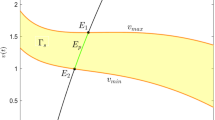Abstract
A mathematical model for the dynamics of a prey–dependent consumption model concerning integrated pest management is proposed and analyzed. We show that there exists a globally stable pesteradication periodic solution when the impulsive period is less than some critical values. Furthermore, the conditions for the permanence of the system are given. By using bifurcation theory, we show the existence of a nontrival periodic solution if the pest–eradication periodic solution loses its stability. When the unique positive periodic solution loses its stability, numerical simulation shows there is a characteristic sequence of bifurcations, leading to a chaotic dynamics, which implies that dynamical behaviors of prey–dependent consumption concerning integrated pest management are very complex, including period–doubling cascades, chaotic bands with periodic windows, crises, symmetry–breaking bifurcations and supertransients.
Similar content being viewed by others
References
Van Lenteren, J. C.: Integrated pest management in protected crops, in: D. Dent (Ed.), Integrated pest management, Chapman & Hall, London, 311–320, 1995
University of California, Division of Agriculture and Natural Resources. Integrated Pest Management for Alfafa hay, Publication 3312, Publications, Division of Agriculture and Nature Resources, University of Califania, 6701 San Pablo Avenue, Oakland CA 94608–1239, 1981
Parker, F. D.: Management of pest populations by manipulating densities of both host and parasites through periodic releases, In: Huffaker, C. B., Ed. Biological control, New York: Plenum Press, 1971
Barclay, H. J.: Models for pest control using predator release, habitat management and pesticide release in combination. J. Applied Ecology, 19, 337–348 (1982)
Freedman, H. J.: Graphical stability, enrichment, and pest control by a natural enemy. Math. Biosci, 31, 207–225 (1976)
Van Lenteren, J. C.: Measures of success in biological control of anthropoids by augmentation of natural enemies, in: S. Wratten, G. Gurr (Eds.), Measures of success in biological control, Kluwer Academic Publishers, Dordrecht, 77–89, 2000
Grasman, J., Van Herwaarden, O. A., Hemerik, L., Van Lenteren, J. C.: A two–component model of hostparasitoid interactions: determination of the size of inundative releases of parasitoids in biological pest control. Math. Biosci., 169, 207–216 (2001)
Bainov, D., Simeonov, P.: Impulsive differential equations: periodic solutions and applications, Ptiman Monographs and Surveys in Pure and Applied Mathematics 66, 1993
Lakshmikantham, V., Bainov, D., Simeonov, P.: Theory of impulsive differential equations. World Scientific, Singapore, 1989
Lotka, A. J.: Undated oscillations derived from the law of mass action. J. Amer. Chem. Soc., 42, 1595–1599 (1920)
Volterra, V.: Variations and fluctuations of a number of individuals in animal species living together, Translation In: R. N. Chapman: Animal Ecology, New York: McGraw Hill, 409–448, 1931
Lakmeche, A., Arino, O.: Bifurcation of non trivial periodic solutions of impulsive differential equations arising chemotherapeutic treatment. Dynamics of Continuous, Discrete and Impulsive System, 7, 265–287 (2000)
Grebogi, C., Ott, E., Yorke, J. A.: Crises, sudden changes in chaotic attractors and chaotic transient. Physica D, 7, 181–200 (1983)
Riidiger, S.: Practical bifurcation and stability analysis from equilibrium to chaos, Springer–Verlag, New York, 1994
Hasting, A., Figgins, K.: Persistence of transitions in spatially structured ecological models. Science, 263, 1133–1137 (1994)
Author information
Authors and Affiliations
Corresponding author
Additional information
This work is supported by National Natural Science Foundation of China (10171106), and supported by Science and Research Project Foundation of Liaoning Province Education Department
Rights and permissions
About this article
Cite this article
Liu, B., Zhang, Y.J., Chen, L.S. et al. The Dynamics of a Prey–dependent Consumption Model Concerning Integrated Pest Management. Acta Math Sinica 21, 541–554 (2005). https://doi.org/10.1007/s10114-004-0476-2
Received:
Accepted:
Published:
Issue Date:
DOI: https://doi.org/10.1007/s10114-004-0476-2




